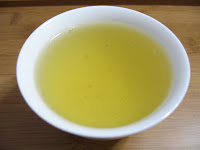 Tea: Phoenix Oolong
Tea: Phoenix OolongVendor: Swan Sisters
Price: $25/oz
Source: Guangdong, China
About This Tea: This is a Phoenix / Dan Cong oolong in limited offering from Swan Sisters. Their supply is only for the local market (SLO). It is not available on their website.
Leaf: The leaf for this tea is very dark in color, almost black. It is very light and fluffy with very light density.
1st Infusion Parameters: 3g, 5 oz, 208F, 5s rinse, 45s
 1st Infusion: This tea is very light and unique aroma. It is hard to describe, but is the most alluring aspect of this tea. The aroma is sweet and malty at the same time, yet more than just that. The tea itself is a golden brown color. The flavor is light and crisp, and it moves quickly through the mouth to flush with a full bodied flavor. It is rich and smooth at the same time.
1st Infusion: This tea is very light and unique aroma. It is hard to describe, but is the most alluring aspect of this tea. The aroma is sweet and malty at the same time, yet more than just that. The tea itself is a golden brown color. The flavor is light and crisp, and it moves quickly through the mouth to flush with a full bodied flavor. It is rich and smooth at the same time.2nd Infusion Parameters: 45s, 208F
2nd Infusion: This infusion was darker, with still a clear brown hue to it. There is a tangy sharpness to the flavor of this infusion. It starts at the tip of the tongue and slides down the tongue. It is sweet, but not sugary similar to the way that a yutakamidori shows it's sweetness. It finishes with a medium astringency.
3rd Infusion Parameters: 1 min, 208F
3rd Infusion: This infusion starts to show a bit more color, with a red/gold hue. The aroma switched over to an almost nutty aroma. The flavor is stronger than the initial flavor. It is rich and flavorful, and significantly thicker. It is not quite as thick as a gyokuro though.
4th Infusion Parameters: 3 min, 208F
4th Infusion: This infusion has a richer brown hue to it. The aroma changed once again. This time it was thicker and more subdued. The flavor was moderate in strength, but started showing signs of easing up. It felt sweeter yet again and left with a medium sense of astringency.
Rating: 8/10
Conclusion: I'm really unable to describe the aroma of the different infusions very well for this tea, but they are quite different from infusion to infusion. I don't have much experience with Dan Cong Oolongs, so I don't have that much to compare them to. I somewhat expected a bit more for the price though. I'll need to compare it against production grade Dan Cong to see how they fare in comparison. On its own though, the flavor was very interesting and refreshing.








































 s season. The O-
s season. The O-





